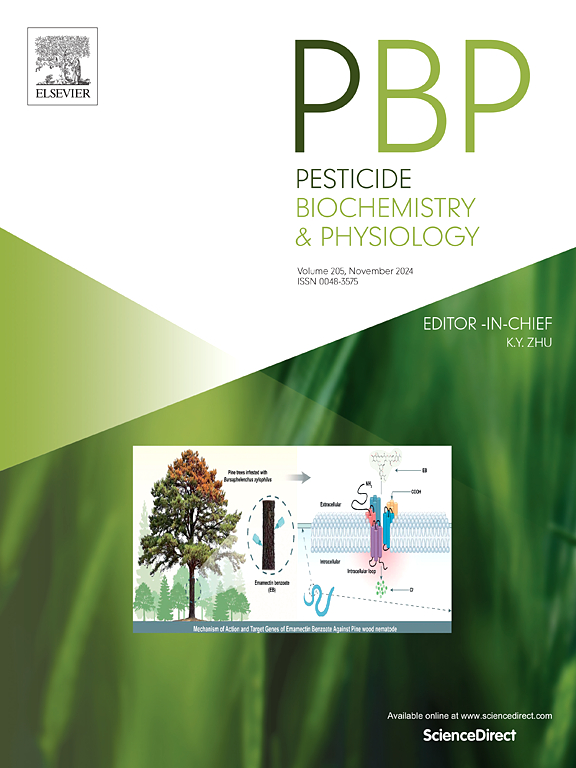Zeolitic imidazolate framework-8 nanoparticles: A promising nano-antimicrobial agent for sustainable management of bacterial leaf streak in rice
IF 4
1区 农林科学
Q2 BIOCHEMISTRY & MOLECULAR BIOLOGY
引用次数: 0
Abstract
Rice bacterial leaf streak (BLS) caused by Xanthomonas oryzae pv. oryzicola (Xoc) significantly reduces rice yield and quality. Traditional chemical control methods often have limited efficacy and raise environmental concerns, highlighting the need for safer and more effective alternatives. This study is the first to comprehensively investigated the antibacterial properties of zeolitic imidazolate framework-8 nanoparticles (ZIF-8 NPs) against Xoc. The ZIF-8 NPs showed strong in vitro bactericidal effects with a half-maximal inhibitory concentration (EC50) of 0.15 mg/mL. The antibacterial mechanism of ZIF-8 NPs involves disrupting bacterial membrane integrity, inducing DNA damage, and triggering an excessive burst of reactive oxygen species, leading to oxidative stress and cell death. Compared to conventional pesticide formulations, ZIF-8 NPs demonstrated superior efficacy in suppressing Xoc growth. In addition, ZIF-8 NPs significantly suppressed the activities of multiple virulence factors of Xoc including extracellular hydrolase (protease, cellulase, and pectinase), extracellular polysaccharide production, and biofilm formation, and showed effective adhesion and bidirectional transport in rice tissues. Greenhouse experiments also revealed that the NPs enhanced the antioxidant activity of some key enzymes in rice, reducing disease severity, while ensuring the biosafety of non-targeted organisms. These findings underline the potential of ZIF-8 NPs as a promising nano-antimicrobial agent for sustainable BLS management, offering an environmentally friendly alternative to conventional pesticides in rice disease control.

咪唑酸分子筛框架-8纳米颗粒:一种有前途的纳米抗菌剂,可用于水稻细菌性条纹病的可持续治理
水稻黄单胞菌引起的水稻细菌性叶斑病。稻曲菌(Xoc)显著降低水稻产量和品质。传统的化学防治方法往往效果有限,并引起环境问题,因此需要更安全、更有效的替代方法。本研究首次全面研究了沸石咪唑酸框架-8纳米颗粒(ZIF-8 NPs)对Xoc的抗菌性能。ZIF-8 NPs具有较强的体外杀菌作用,半数最大抑菌浓度(EC50)为0.15 mg/mL。ZIF-8 NPs的抗菌机制包括破坏细菌膜完整性,诱导DNA损伤,引发活性氧过度爆发,导致氧化应激和细胞死亡。与传统农药制剂相比,ZIF-8 NPs对Xoc生长的抑制效果更好。此外,ZIF-8 NPs显著抑制Xoc胞外水解酶(蛋白酶、纤维素酶和果胶酶)、胞外多糖生成和生物膜形成等多种毒力因子的活性,并在水稻组织中表现出有效的粘附和双向运输。温室实验还表明,NPs增强了水稻中一些关键酶的抗氧化活性,降低了病害严重程度,同时确保了非靶向生物的生物安全性。这些发现强调了ZIF-8 NPs作为可持续BLS管理的有前途的纳米抗菌剂的潜力,为水稻病害控制提供了一种环境友好的替代传统农药。
本文章由计算机程序翻译,如有差异,请以英文原文为准。
求助全文
约1分钟内获得全文
求助全文
来源期刊
CiteScore
7.00
自引率
8.50%
发文量
238
审稿时长
4.2 months
期刊介绍:
Pesticide Biochemistry and Physiology publishes original scientific articles pertaining to the mode of action of plant protection agents such as insecticides, fungicides, herbicides, and similar compounds, including nonlethal pest control agents, biosynthesis of pheromones, hormones, and plant resistance agents. Manuscripts may include a biochemical, physiological, or molecular study for an understanding of comparative toxicology or selective toxicity of both target and nontarget organisms. Particular interest will be given to studies on the molecular biology of pest control, toxicology, and pesticide resistance.
Research Areas Emphasized Include the Biochemistry and Physiology of:
• Comparative toxicity
• Mode of action
• Pathophysiology
• Plant growth regulators
• Resistance
• Other effects of pesticides on both parasites and hosts.

 求助内容:
求助内容: 应助结果提醒方式:
应助结果提醒方式:


